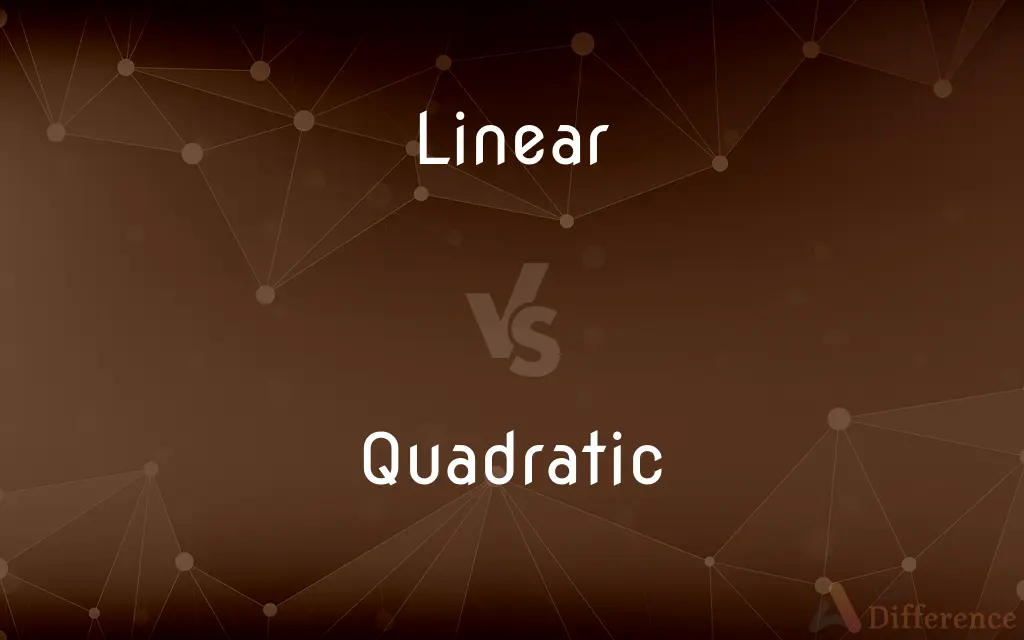Linear vs. Quadratic — What's the Difference?
By Tayyaba Rehman & Maham Liaqat — Updated on March 13, 2024
Linear refers to equations or functions that graph as straight lines, characterized by a constant rate of change, while quadratic equations form parabolas, featuring a squared variable that introduces curvature and variable rates of change.

Difference Between Linear and Quadratic
Table of Contents
ADVERTISEMENT
Key Differences
Linear functions, represented by the formula y=mx+b, where m is the slope and b is the y-intercept, describe relationships with a constant rate of change. This means that for any equal increments in the independent variable (typically x), there's a consistent change in the dependent variable (y). In contrast, quadratic functions, typically represented as y=ax2 +bx+c, involve an 2 x 2 term that causes the graph to curve into a parabola. This curvature indicates a variable rate of change, where the rate accelerates or decelerates based on the value of x.
The graphical representation of a linear equation is a straight line, which can extend infinitely in both directions along the plane. Quadratic equations graph as parabolas, which can open upwards or downwards depending on the sign of the coefficient a. The parabola's vertex represents the maximum or minimum point, a feature not present in linear graphs due to their constant slope.
Linear equations are often used to model situations where relationships between two variables are proportional and additive, such as calculating distance over time at a constant speed. Quadratic equations are suited to modeling scenarios where the rate of change itself changes over time, such as the trajectory of a projectile under the influence of gravity.
Solving linear equations typically involves finding the values of x that make the equation true for a given y, often resulting in a single solution. Solving quadratic equations can result in two solutions, corresponding to the points where the parabola intersects the x-axis, and involves techniques such as factoring, completing the square, or using the quadratic formula.
Comparison Chart
Formula
Y=mx+b
Y=ax2 +bx+c
ADVERTISEMENT
Graph Shape
Straight line
Parabola
Rate of Change
Constant
Variable
Typical Uses
Proportional relationships
Situations with changing rates of change
Solutions
Typically one solution for a given y
Can have two solutions, no solution, or one solution
Compare with Definitions
Linear
Involves a constant rate of change.
The cost increases linearly with the number of items purchased.
Quadratic
Features a squared variable, introducing curvature.
The area of a square can be modeled by a quadratic equation based on the side length.
Linear
Graphs as a straight line.
A plot of temperature versus time for a steadily heating object is linear.
Quadratic
Used for equations with variable rates of change.
Acceleration due to gravity can be represented by a quadratic equation.
Linear
Equation form is y = mx+b.
In the equation y = 3x+2, 3 is the slope and 2 is the y-intercept.
Quadratic
Graphs as a parabola.
The trajectory of a ball thrown upwards forms a parabolic path.
Linear
Has a uniform gradient.
A linear graph's slope remains the same throughout.
Quadratic
Can have zero, one, or two x-intercepts.
Depending on its coefficients, a quadratic equation may not intersect the x-axis.
Linear
Used in simple proportional relationships.
The distance traveled is linearly related to speed when time is constant.
Quadratic
Equation form is y=ax2 +bx+c.
In y = 2 x 2 − 4x+1, 2 is the coefficient affecting the parabola's width.
Linear
Arranged in or extending along a straight or nearly straight line
Linear movement
Quadratic
Of, relating to, or containing quantities of the second degree.
Linear
Progressing from one stage to another in a single series of steps; sequential
A linear narrative
Quadratic
Square-shaped
Linear
Of, relating to, or resembling a line; straight.
Quadratic
(mathematics) of a polynomial, involving the second power (square) of a variable but no higher powers, as . Category:en:Polynomials
Linear
In, of, describing, described by, or related to a straight line.
Quadratic
(mathematics) of an equation, of the form .
Linear
Having only one dimension.
Quadratic
(mathematics) of a function, of the form .
Linear
Characterized by, composed of, or emphasizing drawn lines rather than painterly effects.
Quadratic
(mathematics) A quadratic polynomial, function or equation.
Linear
(Botany) Narrow and elongated with nearly parallel margins
A linear leaf.
Quadratic
Of or pertaining to a square, or to squares; resembling a quadrate, or square; square.
Linear
Having the form of a line; straight or roughly straight; following a direct course.
Quadratic
Tetragonal.
Linear
Of or relating to lines.
Quadratic
Pertaining to terms of the second degree; as, a quadratic equation, in which the highest power of the unknown quantity is a square.
Linear
Made, or designed to be used, in a step-by-step, sequential manner.
A linear medium
Quadratic
An equation in which the highest power of an unknown quantity is a square
Linear
Long and narrow, with nearly parallel sides.
Quadratic
A polynomial of the second degree
Linear
(mathematics) Of or relating to a class of polynomial of the form . Category:en:Polynomials
Quadratic
Of or relating to or resembling a square;
Quadratic shapes
Linear
(physics) A type of length measurement involving only one spatial dimension as opposed to area or volume.
A linear meter
Quadratic
Of or relating to the second power;
Quadratic equation
Linear
(radio slang) linear amplifier.
Linear
Of or pertaining to a line; consisting of lines; in a straight direction; lineal.
Linear
Like a line; narrow; of the same breadth throughout, except at the extremities; as, a linear leaf.
Linear
Thinking in a step-by-step analytical and logical fashion; contrasted with holistic, i.e. thinking in terms of complex interrelated patterns; as, linear thinkers.
Linear thinkers concluded that by taking the world apart, the actions of people were more predictable and controllable.
Linear
Designating or involving an equation whose terms are of the first degree
Linear
Of or in or along or relating to a line; involving a single dimension;
A linear foot
Linear
Of a circuit or device having an output that is proportional to the input;
Analogue device
Linear amplifier
Linear
Of a leaf shape; long and narrow
Linear
Measured lengthwise;
Cost of lumber per running foot
Common Curiosities
What does the coefficient a in a quadratic equation affect?
The coefficient a affects the width and direction (upward or downward opening) of the parabola in a quadratic equation.
Can a linear equation have a squared term?
No, the presence of a squared variable term would make the equation quadratic, not linear.
Are all straight lines represented by linear equations?
Yes, all straight lines can be represented by linear equations, but the slope and intercept may vary.
How can quadratic equations be solved?
Quadratic equations can be solved by factoring, completing the square, graphing, or using the quadratic formula.
Can quadratic equations have more than two solutions?
In the real number system, quadratic equations can have a maximum of two solutions, but they may also have one or no real solution.
What role does the y-intercept b play in linear equations?
The y-intercept b in linear equations represents the point where the line crosses the y-axis, indicating the value of y when x=0.
What defines a linear equation?
A linear equation is defined by a straight-line graph and a constant rate of change, typically in the form y=mx+b.
How do quadratic equations differ from linear ones?
Quadratic equations involve a squared variable, leading to a parabolic graph and variable rates of change, unlike the constant rate of linear equations.
How is the vertex of a parabola determined in a quadratic equation?
The vertex of a parabola in a quadratic equation can be found using the formula −b/(2a) for the x-coordinate, and then substituting this back into the equation for y.
Why are linear equations considered simpler than quadratic equations?
Linear equations are considered simpler due to their constant rate of change and straightforward graphical representation as a straight line, unlike the variable rates and parabolic graph of quadratic equations.
Share Your Discovery

Previous Comparison
Bow vs. Truckle
Next Comparison
Episcope vs. EpidiascopeAuthor Spotlight
Written by
Tayyaba RehmanTayyaba Rehman is a distinguished writer, currently serving as a primary contributor to askdifference.com. As a researcher in semantics and etymology, Tayyaba's passion for the complexity of languages and their distinctions has found a perfect home on the platform. Tayyaba delves into the intricacies of language, distinguishing between commonly confused words and phrases, thereby providing clarity for readers worldwide.
Co-written by
Maham Liaqat















































